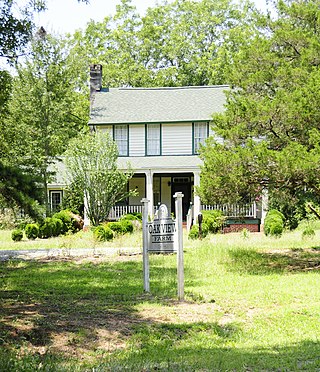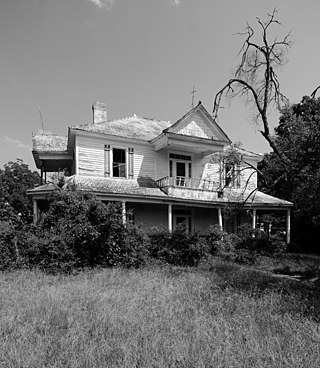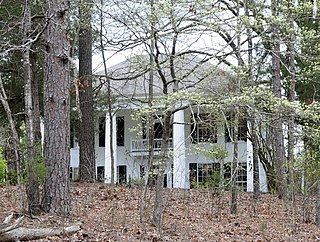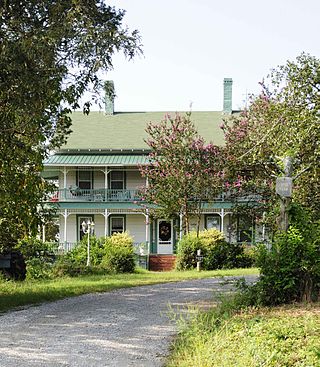
Craig House is a historic home located near Lancaster, Lancaster County, South Carolina. The House was originally owned by John Craig, Esquire, whose family originated in southwestern Scotland, immigrated to South Carolina from Northern Ireland in 1772. After receiving a land grant in Lancaster County from King George III, Craig bought additional land in the Waxhaws in 1773.
Bob Lemmon House is a historic farmhouse located near Winnsboro, Fairfield County, South Carolina. It was built about 1850, and is a two-story, frame I-house. It has a gable roof, a single pile, central hall plan, and rear shed room additions. The façade features a two-tiered pedimented portico with four wooden Tuscan order columns. The property also includes a shed and a barn, both of frame construction sheathed in weatherboard.

Camp Welfare is a historic African-American religious campground located near Monticello, Fairfield County, South Carolina. It was founded after the American Civil War by the African Methodist Episcopal Zion Church. It is a collection of approximately 100 one-story, frame, weatherboarded cabins called tents arranged in a double "U"-shape. The focal point of the camp is the arbor; a rough, gable roofed wooden shelter with wooden benches. Also located at the camp is Zion Church; a frame building with a gable roof surmounted by a belfry built about 1930.

Annandale Plantation, originally known as Millbrook, is a historic plantation house located near Georgetown, in Georgetown County, South Carolina.

Moore-Kinard House, also known as the J.M.C. Kinard House, is a historic home located near Ninety Six, Greenwood County, South Carolina. It was built about 1835, and is a two-story, frame, antebellum central-hall farmhouse, or I-house. Additions were made to the rear and one side of the house about 1900. Also on the property are the following contributing late-19th or early-20th century outbuildings: a smokehouse, cotton house, tool shed, ironing house, and well.
Midfield Plantation, also known as Ellerbe House and Boineau House, was a historic plantation house located near Boykin, Kershaw County, South Carolina. It was built about 1821, and was a two-story, hip roofed, frame dwelling on a high masonry basement. It had rear additions added about 1900. The original kitchen and smokehouse are still on the property as remains.
Benjamin McCoy House, also known as Banbury Cross, is a historic home located near Cassatt, Kershaw County, South Carolina. It was built about 1820, and is a two-story I-house. It has heavy timber-frame construction and brick exterior brick chimneys.

Dr. William Columbus Cauthen House, also known as Oak View Farm, is a historic home located near Kershaw, Lancaster County, South Carolina. It was built about 1848, and is a two-story, frame, weatherboarded, central-hall farmhouse, or I-house. Also on the property are a log barn and a frame barn and shed. It is the oldest known residence in Lancaster County and was the home of Dr. William Columbus Cauthen, who was involved in state politics.

Thomas Walker Huey House is a historic home located near Lancaster, Lancaster County, South Carolina. It was built in 1847–1848, and is a simple, two-story, clapboard-sided, Greek Revival style dwelling. It has a full-façade one-story shed roof porch. Thomas Walker Huey (1798–1854) was a prominent 19th century merchant, planter, and politician.

William Harrison Sapp House is a historic home located near Tradesville, Lancaster County, South Carolina. It was built about 1897, and extensively remodeled in 1912. It is a two-story Colonial Revival style frame residence with a one-story rear projection. It features a one-story hipped-roof wraparound porch, supported by Tuscan order columns. A small one-story gable-front frame drug store/office built in 1912, is located on the property. Dr. William Harrison Sapp (1866-1946), was a prominent local physician and farmer.
Adam Ivy House is a historic home located near Van Wyck, Lancaster County, South Carolina. It was built about 1849–1850, and is a two-story, vernacular Greek Revival style frame dwelling. It has a full-width, one-story front porch. Additions and renovations took place around 1920. Also on the property are two contributing outbuildings; large and small barns located near the house.

Massey-Doby-Nisbet House is a historic home located near Van Wyck, Lancaster County, South Carolina. It was built about 1790, and was originally two stories with one room on each floor. The house was enlarged and remodeled about 1830, which doubled the size and added Federal detailing. The house was remodeled again about 1935.

Nickels-Milam House is a historic plantation house located near Laurens, Laurens County, South Carolina. It was built about 1828, and is a three-story, five bay, Greek Revival style frame dwelling. The interior has original moldings, paneled doors, mantels, wide-board flooring and much of the original hardware. Also on the property are several barns and the family cemetery.

Ballentine-Shealy House, also known as the Ballentine-Shealy-Slocum House, is a historic home located near Lexington, Lexington County, South Carolina. It was built in the late-18th or early-19th century, and is a 1+1⁄2-story, rectangular log building. It is sheathed in weatherboard and has a standing seam metal gable roof. It has shed rooms on the rear and a one-story shed-roofed front porch with an enclosed room. The house has a hall-and-parlor plan and an enclosed stair. An open breezeway connects the house to the kitchen, which has a fieldstone and brick chimney and a side porch. Also on the property a dilapidated dairy, a small log barn, and a well house.

John Albert Gibert M.D. House is a historic home located near McCormick in McCormick County, South Carolina. It was built about 1867, and is a two-story, frame, I-house embellished with Greek Revival style decorative elements. It features a full-height portico supported by massive Doric order masonry columns. Also on the property is a one-story frame outbuilding, originally a single dwelling, but which later served as a general store.

Guillebeau House is a historic home located in Hickory Knob State Resort Park near Willington in McCormick County, South Carolina. It was built in about 1764 and is a double-pen log house with one exterior chimney and two front entrances. It has a full-width, shed-roof porch.

Moon-Dominick House, also known as the Old Tin House, is a historic home located near Chappells, Newberry County, South Carolina. It was built about 1820, and is a 2+1⁄2-story, frame I-house with Federal style details. It has a high brick basement, gable roof, and exterior end chimneys.
Cattle Creek Campground, also known as Cattle Creek United Methodist Church and Campground, is a historic camp meeting ground that is now a national historic district located near Rowesville, Orangeburg County, South Carolina. The district encompasses 37 contributing buildings and 1 contributing site. It was founded in 1786, although this date has been challenged. The campground burned in 1898 and was rebuilt. Another fire in 2017 destroyed 15 "tents," which were again rebuilt. It includes 36 cabins, called “tents,” arranged in a wide semi-circle. They are located around an open, 56 feet by 81 feet, pavilion structure known as the “stand” or “tabernacle.” Also located on the property is a cemetery. It is one of three remaining Methodist campgrounds in South Carolina.

John Jacob Calhoun Koon Farmstead is a historic home and farm located near Ballentine, Richland County, South Carolina, USA. The house was built in about 1890, and is a two-story farmhouse with a two-tiered Victorian influenced wraparound porch. It has a one-story, gable roofed frame rear addition. Also on the property are the contributing frame grain barn, a frame cotton house, a frame workshop/toolhouse, a late-19th century shed, a planing shed and a sawmill.

Willtown Bluff, also known as Wilton and New London, is a historic settlement site located on the S. Edisto River near Adams Run, Charleston County, South Carolina. Founded about 1704, it was the second planned town to be established after the relocation of Charleston in 1682. Willtown served as a local governmental center and regional commercial center. The property includes three early-19th-century buildings: the Parsonage, the Willtown Plantation House, and the remains of a single column of the Episcopal Church. Unexposed remains are of a colonial village thought to have had 80 houses.



















